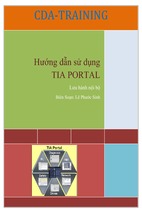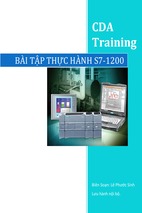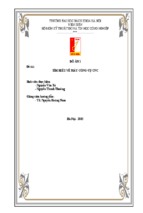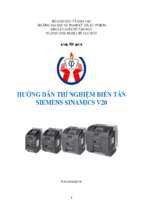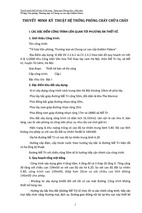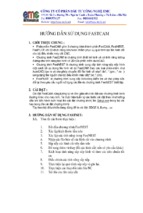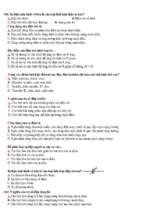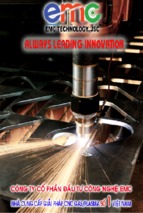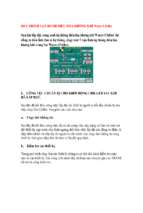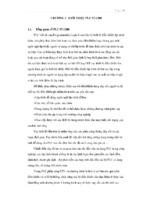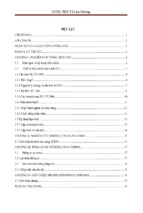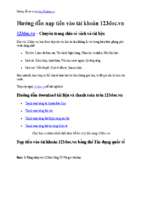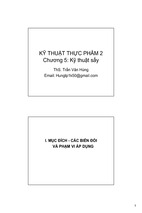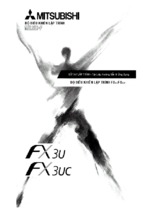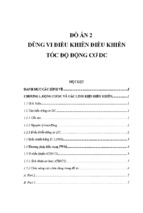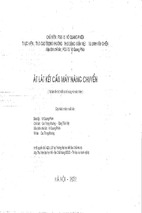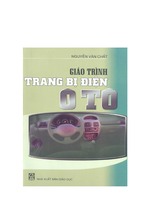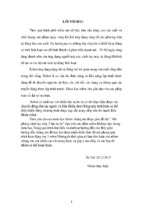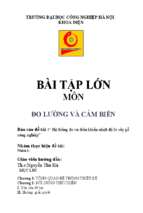Mô tả:
Sustainable Manufacturing and Factory
Planning
Production Planning and Control (PPC) II
13.04.2017
Technische Universität Berlin
Institute for Machine Tools and Factory Management
Univ.-Prof. Dr.-Ing. Holger Kohl
© IWF TU Berlin
Page 1
Content
Production Principles and Production Types
PPC Best Practices
Literature and References
Technische Universität Berlin
Institute for Machine Tools and Factory Management
Univ.-Prof. Dr.-Ing. Holger Kohl
Page 2
Aim of production control
The task of Production Control is to organize that the right product with the right
specification (quality) and right quantity will reach the customer at the right time
The tasks becomes increasingly difficult because of increased variants and short
time delivery expectations and globally distributed production sites and suppliers
Customer
orders a product
Customer
receives product
Production control
Supplier
Technische Universität Berlin
Institute for Machine Tools and Factory Management
Univ.-Prof. Dr.-Ing. Holger Kohl
Production
Page 3
Three level concept and control loop
Technische Universität Berlin
Institute for Machine Tools and Factory Management
Univ.-Prof. Dr.-Ing. Holger Kohl
Page 4
Levels of Production Planning and Control
Planning:
Determination of General Data
Network Scheduling
Order Network Management
ERP System
Order Network
Product
Planning Level
Control:
Detailed Planning and
Implementation
Scheduling and Load-In
Progress Control
Deviation Control
Order Key Features
Work Schedules
Condensed
Feedback Data
Manuf. Exec. System
Control Area 1
Process:
Execution
Processing
Manufacturing Progress
Fault Value
Process Data
Control Area 2
AFO Release
Control Area 3
AFO Release
FDA
MDA
Shop Floor
Manufacturing Area 1
Manufacturing Area 2
Manufacturing Area
FDA Factory data acquisition
MDA Machine data acquisition
AFO Work Sequence
Technische Universität Berlin
Institute for Machine Tools and Factory Management
Univ.-Prof. Dr.-Ing. Holger Kohl
Page 5
Control Circuit Model of Production Control
Corporate
Goals
Planning
System
(medium-term)
Planning
System
(long-term)
MODEL SYSTEM
Target
Values
KPIs
Planning
System
(short-term)
FDA
REAL SYSTEM
Shop Floor
Information Flow
Material Flow
Technische Universität Berlin
Institute for Machine Tools and Factory Management
Univ.-Prof. Dr.-Ing. Holger Kohl
Disturbances
KPI Key Performance Indicator
FDA Factory Data Acquisition
Page 6
Examples of order sheets
Documents to be handled during Production Control:
Request by customer
Offer by producer using BOM Bill of Material
Order by customer
Internal Worksheet (production steps, duration and
machines/workplaces)
Internal manufacturing orders
Accompanying papers
Quality documents and
delivery slip and invoice
Technische Universität Berlin
Institute for Machine Tools and Factory Management
Univ.-Prof. Dr.-Ing. Holger Kohl
Page 7
Production Principles I
Production Principle
Workbench Principle
Organizational Criterion
Example
Manual Work Centers
Human
Assembly Tasks
S1
P1
S2
P2
S3
P1
W
Interaction
Material Flow
P
Product
S
Station (Assembly work place, Machine tool)
Technische Universität Berlin
Institute for Machine Tools and Factory Management
Univ.-Prof. Dr.-Ing. Holger Kohl
W
Worker
Source: [Löd-13]
Page 8
Production Principles II
Production Principle
On-site Principle
Organizational Criterion
Example
Heavy machine construction
Product
Shipyard
S1
Raw Material,
Components
S2
S3
P
(Work Object)
Interaction
Material Flow
P
Product
S
Station (Assembly work place, Machine tool)
Technische Universität Berlin
Institute for Machine Tools and Factory Management
Univ.-Prof. Dr.-Ing. Holger Kohl
W
W
Worker
Source: [Löd-13]
Page 9
Production Principles III
Production Principle
Organizational Criterion
Work Shop Principle (or
Function Principle)
Example
Turnery
Manufacturing
Technology
Grindery
P2
Turnery
S5
S6
P2
P2
Drilling
P2
S3
S4
Material
Flow
Grindery
P1
P1
S1
S2
P1
P2
P
Product
S
Station
(Assembly
work place,
Machine
tool)
P1
P2
P1
Technische Universität Berlin
Institute for Machine Tools and Factory Management
Univ.-Prof. Dr.-Ing. Holger Kohl
Source: [Löd-13]
Page 10
Production Principles IV
Production Principle
Organizational Criterion
Group Principle (or Cellular
Principle) (Typically U-Shape)
Example
Manufacturing Cell
Material Flow of Part Family
Assembly Cell
Material Flow
S3
S4
P1
P1
P2
S1
S2
P1
P1
P
Product
P2
P2
S
Station
(Assembly work place,
Machine tool)
P1
P1
P2
P2
Technische Universität Berlin
Institute for Machine Tools and Factory Management
Univ.-Prof. Dr.-Ing. Holger Kohl
Source: [Löd-13]
Page 11
Production Principles V
Production Principle
Flow Principle
P1
Organizational Criterion
Production Line
Material Flow of defined
Variants
S1
P1
S2
P1
S3
Example
Assembly Line
P1
S4
P1
P1
Material Flow
P
Product
S
Station (Assembly work place, Machine tool)
Technische Universität Berlin
Institute for Machine Tools and Factory Management
Univ.-Prof. Dr.-Ing. Holger Kohl
Source: [Löd-13]
Page 12
Lot size in manufacturing
costs
Storage costs
Set up costs
Total costs
Lot size
Technische Universität Berlin
Institute for Machine Tools and Factory Management
Univ.-Prof. Dr.-Ing. Holger Kohl
Source: [VNL-ol]
Page 13
Production Types I
Criteria:
Average size of the manufacturing run (lot size)
Average number of repetitions per year for the manufacturing runs
Small production
run
No repetitions
Serial production
Size of production
Size of production
run < 50
run > 50
Number of
Number of
Airplanes
Technische Universität Berlin
Institute for Machine Tools and Factory Management
Univ.-Prof. Dr.-Ing. Holger Kohl
Very large
production runs
Continuous
repetitions < 24
valc.com.vn
cad-ingenieur.de
repetitions < 12
Plants
Mass production
production
Luxury cars
techfleece.com
Single or small series
production
eurocarblog.com
One of a kind
production
Mobile phones
Source: [Löd-13]
Page 14
Production Types II
Production types
Dominating
organizational principle
Relation to customers‘ orders
One of a kind production
On-site principle
Customized non-repetitive
Workbench principle
production
Make-to-order production
Single or small series
production
On-site principle
Make-to-order production
Work Shop principle
Assembly-to-order production
Workbench principle
Serial production
Mass production
Technische Universität Berlin
Institute for Machine Tools and Factory Management
Univ.-Prof. Dr.-Ing. Holger Kohl
Work Shop principle
Make-to-order production
Cellular principle
Assembly-to-order production
Flow principle
Make-to-stock production
Flow principle
Make-to-stock production
Source: [Löd-13]
Page 15
Content
Production Principles and Production Types
PPC Best Practices
Literature and References
Technische Universität Berlin
Institute for Machine Tools and Factory Management
Univ.-Prof. Dr.-Ing. Holger Kohl
Page 16
Design Principles of Production Systems
A company sets the production methods, based on super ordinate objectives of productions
(e.g. throughput time, inventory, capacity utilization, quality)
The objectives are controlled by key performance indicators (KPIs)
defined by the manufacturing execution board
Companies often create catalogues of methods and tools to improve the production process
Out of that catalogue manufacturing site managers can select appropriate methods and tools
and implement them to reach the objectives
Check for more information the VDI Guideline 2870
Technische Universität Berlin
Institute for Machine Tools and Factory Management
Univ.-Prof. Dr.-Ing. Holger Kohl
Source: [VDI-2870a]
Page 17
Overview Over Methods and Their Impact on Quality, Cost and Time (1/3)
Principle
Standardization
Zero defects principle
Visual management
Method
Quality
Cost
Time
5S
••
•
••
Process standardization
•••
••
•••
5 x why
•••
•
••
8D report
••
••
••
A3 method
••
••
••
Autonomation
•••
••
••
Ishikawa diagram
••
••
••
Short control loops
••
•
••
Poka Yoke
•••
••
••
Six Sigma
•••
••
••
Statistical process control
•••
•
•
Worker self-check
•••
••
••
Andon
•••
•
••
Shop floor management
•••
•••
•••
Further focus
Technische Universität Berlin
Institute for Machine Tools and Factory Management
Univ.-Prof. Dr.-Ing. Holger Kohl
Impact on objectives:
Low
Medium
High
Source: [VDI-2870b]
Page 18
Overview Over Methods and Their Impact on Quality, Cost and Time (2/3)
Principle
Continuous
improvement
Method
Quality
Cost
Time
Audit
••
••
••
Benchmarking
••
••
••
•
•••
••
•••
•••
•••
PDCA1
••
••
••
Hancho
•••
••
••
Target management
••
••
••
First in first out
••
•
•
One piece flow
•••
•••
•••
Quick changeover
•
••
•••
Value stream planning
•
••
•••
U layout
•
•
•••
Cardboard engineering
Idea management
Employee orientation
and management by
objectives
Flow principle
Note 1): PDCA: Plan Do Check Act
Further focus
Technische Universität Berlin
Institute for Machine Tools and Factory Management
Univ.-Prof. Dr.-Ing. Holger Kohl
Impact on objectives:
Low
Medium
High
Source: [VDI-2870b]
Page 19
Overview Over Methods and Their Impact on Quality, Cost and Time (3/3)
Principle
Pull principle
Avoidance of waste
Method
Quality
Cost
Time
Just in time / just in
sequence
•
••
••
Kanban
•
•••
•••
Milk run
•
••
••
Production Leveling
•
•
••
Supermarket
•
••
••
Chaku Chaku
•
••
••
Low cost automation
•
•••
••
Total productive
maintenance
•
•••
•
Waste analysis
•
•••
••
A detailed description of the methods is given in VDI 2870, Part 2 [VDI-2870b].
Further focus
Technische Universität Berlin
Institute for Machine Tools and Factory Management
Univ.-Prof. Dr.-Ing. Holger Kohl
Impact on objectives:
Low
Medium
High
Source: [VDI-2870b]
Page 20
- Xem thêm -

